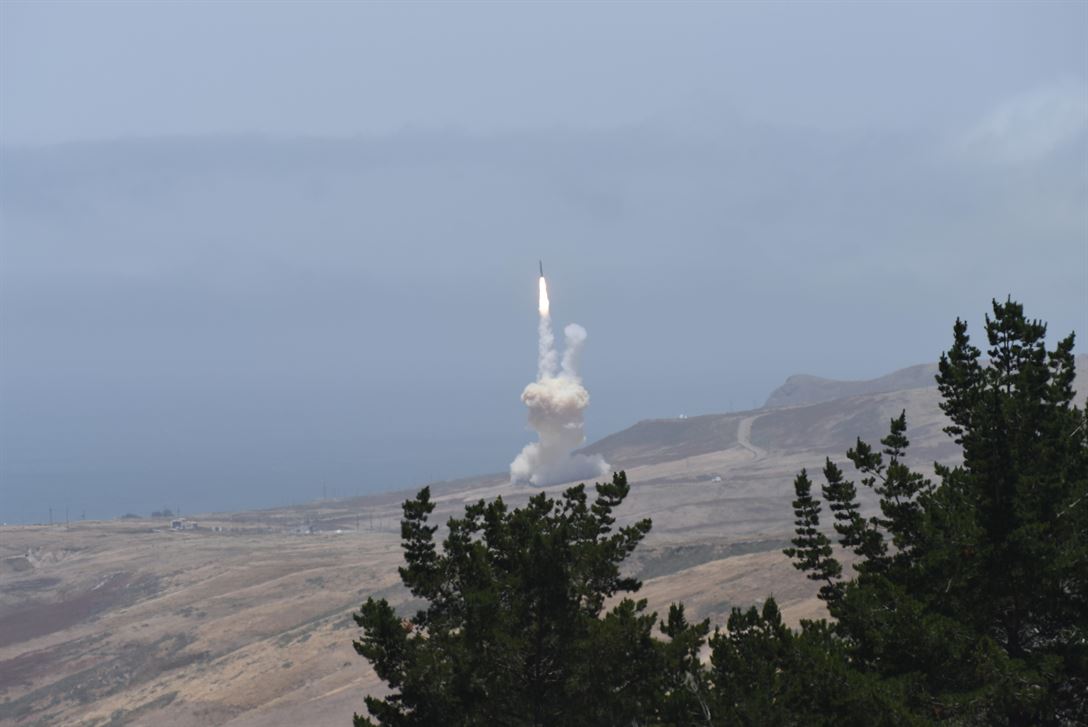A long-range ground-based interceptor launches from Vandenberg AFB, Calif., May 30, 2017, to intercept an intercontinental ballistic missile target that was launched from the US Army’s Reagan Test Site on Kwajalein Atoll in the Marshall Islands. This was the first live-fire test event against an ICBM-class target. The ground-based midcourse defense is an element of the Ballistic Missile Defense System. DOD photo by SrA. Robert J. Volio.
The successful test of the Ground-based Midcourse Defense (GMD) system on Tuesday validated key system upgrades and ensured the US can defend itself against ballistic missile threats through 2020.
The interception of a mock intercontinental ballistic missile with a ground-based interceptor was “a complete end-to-end system test” that “validated the performance of our upgrades,” Norm Tew, Vice President and GMD Program Director at Boeing, told reporters on a conference call Wednesday.
That validation was necessary to move forward with US plans to add eight more interceptors to the inventory by the end of 2017, bringing the total to 44 fielded interceptors, he said.
“All indications are that all our system performed exactly as designed,” Vice Adm. James Syring, director of the Missile Defense Agency, told reporters Wednesday at a Pentagon briefing. Syring said the threat scenario was specifically designed with North Korean and Iranian capabilities in mind. “I was confident before the test that we had the capability to defeat any threat that [North Korea or Iran] would throw at us,” he said, adding the test confirmed that.
Boeing is the primary contractor for GMD. Northrop Grumman, Orbital ATK, and Raytheon are partners in operating a system that spans 15 time zones and employs 800 civilian workers and provides “our only active defense against the threat of long-range ballistic missiles,” Tew said.
From either of two launch sites at Vandenberg AFB, Calif., or Fort Greely, Ala., GMD provides ballistic missile defense of “the continental United States, Alaska, and Hawaii,” Tew said.
Since a series of program failures between 2010 and 2013, Boeing has been working to refine the system.
Tuesday’s test saw “the maiden flight” of the CE-2 block 1 interceptor, which features “extensive modifications and focused reliability and performance enhancements,” and will be deployed for the first time late this year. The key to producing a more reliable interceptor, Tew said, was developing designs that could “accommodate those pretty stressful space environments.”
As such, upgrades to the CE-2 block 1 focused on “the boost vehicle” and included “a pretty extensive set of avionics improvements, modernizations, and performance enhancements.” Boeing has also worked with its partners to update ground control systems, including “the command launch equipment, a lot of the silo systems, [and] the fire control systems.”
Tew gave credit to “a very stressing, rigorous testing and qualification program,” for producing changes that continue to “improve reliability and sustainability” of the GMD.
Tuesday’s test demonstrated all aspects of the GMD including “threat launch” and “early detection,” with “multiple operational sensors” feeding data into the “fire control system.” After separation from the booster, the Exoatmospheric Kill Vehicle (EKV) “was provided data in-flight” on the ICBM threat and “then it was on its own to hunt and kill, with that data that it was provided.”
The in-flight updates helped the EKV in detecting and identifying the test ICBM threat and “using its onboard sensors all the way to intercepting and destroying the target.” The EKV takes out an ICBM “through only the force of collision,” Tew said.
He added that a “key consideration of the test design” was to “minimize the impact of debris created” by the explosion in space, though he said he could not give details of the preparations.
After the successful test, Syring said he is confident the GMD program will be able to address current and developing threats through the year 2020, based on US intelligence reports about global ballistic missile capabilities.
The next test of the system will be later this year or in 2018 and will involve a “salvo” launch of multiple interceptors at a single target, Tew said. Syring said MDA should be ready to test interception of a salvo ICBM threat—that is, the interception of multiple incoming missiles—by 2023.
